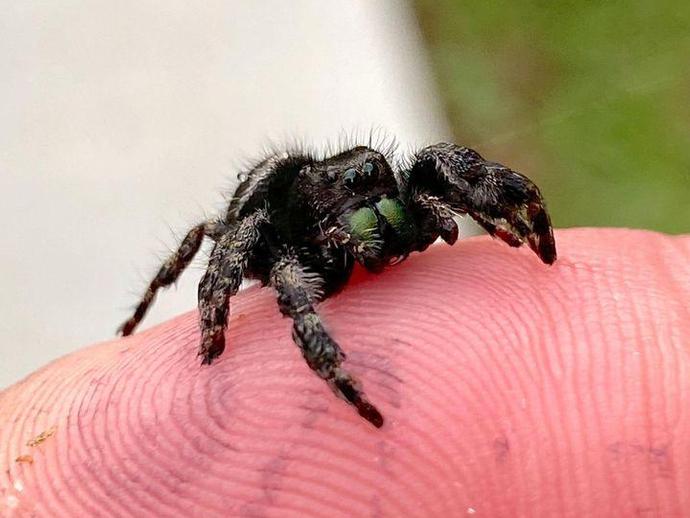July 28, 2021
Ben here with the Wednesday edition of #BenInNature presented by our friends at Carter Bank & Trust!
I recently had some work done on my garage which included the installation of a new gutter on one side. The ground is high enough on that side of the garage that the gutter comes to chest level on me, and I've discovered that it's an amazing bug trap! I check it every day to see what critters are hanging out in there and rescue any that might be in distress. For example: this bold jumping spider (Phidippus audax)!
This spider was pretty drenched from a recent downpour when I found it and I tried to pick it up with a little twig. It quickly scurried across the twig and then stopped on my thumb. I let it hang out there for a few minutes to dry off before putting it in the grass. If you zoom in close, you can actually see one of its fangs in the photo; however, I wasn't concerned. While jumping spiders can bite, their venom is pretty mild, and they only bite if they feel threatened or endangered.
Bold jumping spiders are common across most of the U.S. and they're fairly easy to identify. The adults are black with white markings and metallic green or blue chelicerae (modified pincer-like claws that arachnids have in front of their mouths). The juveniles have orange markings as well, and adults found in the southernmost parts of their range (Florida, for example) generally keep these orange marks into adulthood.
Jumping spiders don't build traditional webs, although they do use webbing when laying eggs or as a lifeline when making a jump. Instead of catching insects in a web, they're active hunters. Their large forward-facing eyes give them excellent stereoscopic vision that helps them to stalk their prey (and also makes it much easier to anthropomorphize them and ascribe human emotions to them; for example, I could tell this spider was very grateful I rescued it and it probably loves me).
If you'd like to spot one of these guys yourself, they're fairly common in open areas such as fields and grasslands, and they're often seen on vertical surfaces such as fences, probably because it makes it easier for them to keep an eye on any passing delicious insects.
ABOUT #BenInNature
Social distancing can be difficult, but it presents a great opportunity to become reacquainted with nature. In this series of posts, Administrator of Science Ben Williams ventures outdoors to record a snapshot of the unique sights that can be found in the natural world. New updates are posted Monday - Friday, with previous posts highlighted on the weekends. This series of posts is made possible thanks to the support of VMNH Corporate Partner Carter Bank & Trust (www.cbtcares.com).
NATURE PHOTO IDENTIFICATIONS
If you discover something in nature that you would like help identifying, be sure to message us right here on Facebook with a picture (please include location and date of picture) and we'll have our experts help you identify it!

 Hours & Admissions
Hours & Admissions Directions
Directions

